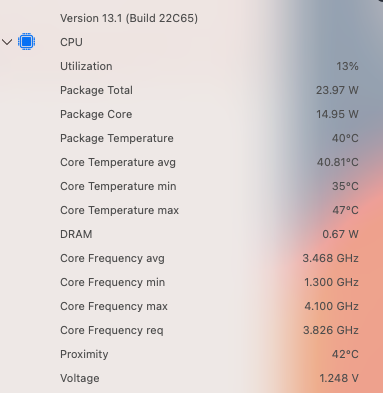I'm here to ask for help with the 6900XT (XTXH variant, Asus in this case). I'm on a Asrock B660M-HDV, BIOS 10.04, using my guide (
https://github.com/dclive/B660M-HDV---i5-1200F), albeit with updated OC87 versions OpenCore and all kexts, validated by OCValidate as good, and happily working with an AMD 5700 under 13.1.
Now, I've removed the 5700 and added the 6900 XT (XTXH, remember) to this system, and so I see:
- GFXUTIL:
- ./gfxutil -f gfx0
03:00.0 1002:73af /PC00@0/PEG1@1/PEGP@0/pci-bridge@0/GFX0@0 = PciRoot(0x0)/Pci(0x1,0x0)/Pci(0x0,0x0)/Pci(0x0,0x0)/Pci(0x0,0x0)
- Hackintool shows the following on PCI tab:
- IOREG path: IOService:/AppleACPIPlatformExpert/PC00@0/AppleACPIPCI/PEG1@1/IOPP/PEGP@0/IOPP/pci-bridge@0
- DEVICE path: PciRoot(0x0)/Pci(0x1,0x0)/Pci(0x0,0x0)/Pci(0x0,0x0)/Pci(0x0,0x1)
- BRIDGE info:
- IOREG Path:
- IOService:/AppleACPIPlatformExpert/PC00@0/AppleACPIPCI/PEG1@1/IOPP/PEGP@0/IOPP/pci-bridge@0
- DEVICE path: PciRoot(0x0)/Pci(0x1,0x0)/Pci(0x0,0x0)/Pci(0x0,0x0)
SystemInfo shows:
AMD Radeon Navi21:
Chipset Model: AMD Radeon Navi21
Type: GPU
Bus: PCIe
PCIe Lane Width: x16
VRAM (Total): 16 GB
Vendor: AMD (0x1002)
Device ID: 0x73af
Revision ID: 0x00c0
ROM Revision: 115-D412BS0-101
..in other words, the expected 73af, b/c I haven't patched it yet.
I'm happy to post a guide on my GitHub, but I am just not clear on what my next steps are - the steps I see in this thread are very abbreviated - more conceptual than anything. What must be done? I have maciasl, I've opened a ssdt-brg0 that I've downloaded, then ... not sure what's next. Here's the default ssdt-brg0:
/*
* This table provides an example of creating a missing ACPI device
* to ensure early DeviceProperty application. In this example
* a GPU device is created for a platform having an extra PCI
* bridge in the path - PCI0.PEG0.PEGP.BRG0.GFX0:
* PciRoot(0x0)/Pci(0x1,0x0)/Pci(0x0,0x0)/Pci(0x0,0x0)/Pci(0x0,0x0)
* Such tables are particularly relevant for macOS 11.0 and newer.
*/
DefinitionBlock ("", "SSDT", 2, "ACDT", "BRG0", 0x00000000)
{
// Fix this path
External (_SB_.PC00.PEG1.PEGP, DeviceObj)
// Fix this path
Scope (\_SB.PC00.PEG1.PEGP)
{
/*
* This is a PCI bridge device present on PEGP.
* Normally seen as pci-bridge in I/O Registry.
*/
Device (BRG0)
{
Name (_ADR, Zero)
/*
* This is an actual GPU device present on the bridge.
* Normally seen as display in I/O Registry.
*/
Device (GFX0)
{
Name (_ADR, Zero) // _ADR: Address
}
}
}
}
I compiled this, saved it into ACPI, added it to ACPI section in config.plist.
I've already added, in config.plist, the device ID bits:
DP
Add
PciRoot(0x0)/Pci(0x1,0x0)/Pci(0x0,0x0)/Pci(0x0,0x0)
^^^ is the above line right? Do I need to use something different based on the far-above output?
and then on the right side in OCAT:
device-id data BF730000
model string AMD 6900 XT (XTXH)
I either get all black screens, permanently, when going into MacOS with these mods (this isn't a pikeradp problem; without these mods it at least goes into MacOS, albeit without accelleration) or I get no changes. Seems like my most recent change (recompiling the asl above) led to a regression sending me to black screens. The change was the PC00 bit you see above, which I changed in order to match the output from my gfxutil output.
I'm now confused.
Help!

